
witzig : bells, 1967
| home | catalogue | history | references | appendix |
 |
surfresearch.com.au
witzig : bells, 1967 |
Breakthrough: The Paddle-Out Entry (take-off) by Robert "Nat " Young and The Skeg-First Takeoff by David Nuuhiwa, pages 33-37.
We're Tops,
Too by "Bahama Pat" Moloney, pages 38-39.
East coast
correspondent invites Australians to Long Beach or Long
Island, New York, to meet some genuine power
surfers.
AAA Oceanside
Invitational
1. Mike Purpus,
2. Corky Carroll, 3. Mark Martinson, 4. David Nuuhiwa, 5. Skip
Frye.
Outstanding
Ride: David Nuuhiwa, page 41.
Although accredited on the contents page, John Witzig does not get a by-line for his article.
This
advertisement by Morey-Pope as a
instance where promotion produces an fascinating technical
analysis of surfboard rocker, as good as any article of the
period.
Integral to the
text is the creation of a wave model by the reader, by bending
the bottom corner of the page over to a printed mark.
The arrows
indicate the graduation in the curve of the wave face, from
"top to bottom" Sunset beach to "bearly rideable" Waikiki.
The scale is
reproduced here on the right hand side of the page, the dots
approximate the relative spacing.
Unfortunately
the intended wave model does not take the required shape when
the printed mark is used, it should be perhaps higher up the
page.
The author appears to avoid any comment on big-wave gun design by noting that, somewhat inaccurately, "the distances between radical changes in the curve of the wave are considerably more than the length of the board."
Advertising
Hobie
Surfboards, Corky Carroll tests experimental stringerless
model (later released as the Flexible), page 2.
Slipcheck, Nuuihwa: I Slipchecked
the whole deck, the most famous image associated with
the product, page 3.
G&S Surfboards, Skip Frye, Mike
Hynson, and Midget Farrelly Stringerless modesls, page
4.
Weber
Surfboards, New Performer with 3 scoop options and 3 nose and
tail widths, pages 6-7.
Grip (spray
wax) and Competition Surfing Wax, World Surfing Products, page
9, page 14.
Morey-Pope, Natural Rocker, page 18.
Severson's Great
Surfing, $5.95, page 21.
Control (spray
wax), Con Surfboards, page 29.
Page 61
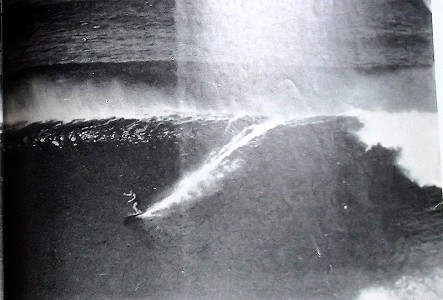
Bob McTavish drops in at Bell's Beach, Australia, for
shot two of the sequence turn the page ...
[McTavish did
not surf in the contest]
Page 62
Involvement
was the name of the game- total involvement- in what may
well have been the greatest contest surf of all time.
It was the
Red Baron against the Blue Max in a fierce surfing dog
fight.
It was
consistently beautiful 10- to 15- foot swells crackling with
precision explosions off the point at Bells Beach.
It was a
great example of the Australian theory of surfing
involvement that has raised the sport to a new pinnacle.
It was the
Australian National Championships.
Imagine
Robert "Nat" Young, the world champion, ripping these
beautiful waves in a savage battle with his not-so-friendly
rival Bernard "Midget" Farrelly, the first world champion.
And then
there was Peter Drouyn finishing with such a rush on the
final day's competition that the nine judges had a difficult
time sorting out the winners.
But when the
final tallies were marked up on the board, it was Nat Young,
nicknamed the Blue Max because he was wearing a blue wet
suit ,who was in the number one position.
Drouyn was
number two, a scant two points ahead of Farrelly, the Red
Baron in his red wet suit.
The
finalists were Young, Farrelly, Bob Brown, Keith Paul (sic)
and Ted Spencer, all from New South Wales; and, of course,
the up-and-coming Drouyn, the Queensland and National junior
champion, who has moved up to the senior division.
Commented
Ray Young, the Aussie team manager:
"Surfers will talk about this final. for a long time, as it fast developed into a real dog fight. .. A new combatant had entered the scene to rival the Red Baron and Blue Max-the Green Hornet, Peter Drouyn, so named after his green wet suit.
"Keith Paul
(sic) put on what must have been his best display, and
I rated him in the first three.
However, the
nine judges did not see it this way.
"After
twenty minutes, the pattern was set.
Nat was
surfing hard, pulling off some unbelievable stuff, but a lot
of this was marred by his "dropping in," and he lost
valuable points by this.
Midget again
rode safely, occasionally becoming: aggressive, but not
enough to get on top."
The
fantastic surfing display at Bells Beach underscored why the
Australian surfing has so far surpassed the American style.
Perhaps one reason is the Aussie boards: they're short (9'
to 9'3", fat (22" to 23'') and thin (2 1/2" center razor
rails) boards.
But it's the
style that makes the difference- the Australians stick close
to that curl, and the accent is on the crouch.
In the words
of top Australian surf theorist Bob McTavish, "In, around,
on top of, and in the curl" is the trade-mark of the great
Australian surfing.
Page 63
Photograph: Bob McTavish - Bell's Beach - totally involved! Shot two of the sequence by John Witzig.
Page 64
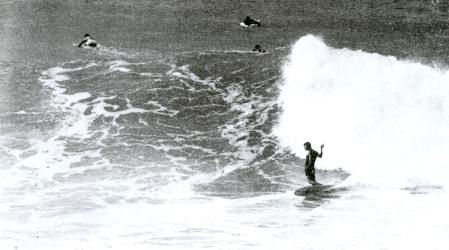 |
Photo: Albert Falzon. Cropped version of
Surfing World
|
The
Australian Championships were set up on the "movable
contest" idea that the Australians had seen in action at the
World Championships at San Diego last October.
However, as
it turned out, the waves at Bells Beach could not be
surpassed- many veterans said they were better than anything
they'd ever seen in the surfing world, including Sunset
Beach in Hawaii.
Both Young and Farrelly- who make no secret of their dislike of each other- had high praise for young Peter Drouyn in their respective surfing columns in Sydney newspapers.
Young, writing in the "Sunday Telegraph," said he was happy that Drouyn had such a good showing "because it proves that there are no biased decisions by our judges and that our judging system is the best in the world.
Page 65
Photographs:
(Above) Nat Young drives across a fabulous glass wall on
his way to the Chamionship. Photo: Falzon.
(Below)
John
"Nipper" Williams plays it tight at Bell's Beach near
Melbourne, Australia. Photo: Albert Falzon.
Page 66
Advertisement: Ramsey Jay Surfboards.
Page 67
Photographs:
(Above) An Australian performer outraces a slick
Bell's wall on his way to the Chamionship. Photo:
Falzon.
(Below)
Butch Cooney bottom turns under the powerful soup.
Photo: Falzon.
Farrelly in
his column stated:
"Nat Young
came away with the first placings in the men's division, and
he rode well, impressing the judges with his positioning on
the bigger waves, and especially with his maneuvers in the
white water.
But for my
money, Peter Drouyn stood out for his powerful bottom turns-
a dangerous competition maneuver in big surf- and his
ability to go through sections inside the waves without
grabbing a rail."
Farrelly
had nice things to say about the Australian judging system,
although he was not as high in praise as was Young.
Commented
Farrelly:
"The
judging system, although not completely flawless, was a vast
improvement over previous competitions.
It's good to
see the standard of Australian competition and judging
improving."
In the
women's division, Gail Couper retained her crown, with Lyn
Stubbins second and Viv Campbell third.
Commented
photographer Albert Falzon, a veteran observer of the
Australian surf scene:
"The finals
of the competition had six top surfers extracting every
possible point from each ride.
The
competition was so fierce and the standard of riding so
high, I found it impossible to separate the placings.
| David Nuuhiwa says:
"They didn't have Slipcheck when I was a kid. I used to slip a lot. The warm Hawaiian water melted the wax and it oozed under my feet. When I came to the Mainland, I found that cold water hardened the wax and made it slick. Slip check solved the problems. I Slipchecked the whole deck of my new lightweight (All these colors weigh less than a bar of wax). I use plenty of wax over the Slipcheck in the places where I lie and shuffle around. The millions of Slip check grains hold the wax like teeth and keep it from rubbing off. Slip check red or black used as a base under the wax keeps it rough in very cold water. Clear, White, and Yellow Slipcheck keeps wax cool in hot weather. For the nose and tail I still use pure Slipcheck without wax. It gives me great footing, just like it did a year ago when I first began using it. When your board is slippery, you just can't get hot. Use genuine Slip check for professional texture. |
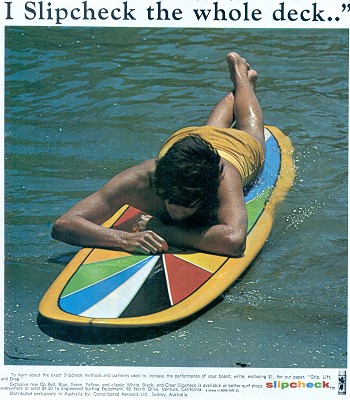 |

| Page
corner ... < Breaks top to bottom Sunset Beach, medium tide, 12 ft. plus. On large wave boards with relatively little rocker work well; the distances between radical changes in the curve of the wave are considerably more than the length of the board. . < 3/4 break Honolula Bay, Rincon, low tide 5-8 ft. You won't make these waves if the rocker in your board is extreme but strong rocker in the tail will keep you in the pocket. .. < Breaks top to center. Malibu, Virginia Beach, medium tide, 3-7 ft. moderate rocker in the tail improves maneuvering and control. Very, very slight rocker near the nose tends to improve noseriding. ... < Wave crumbles or feathers gently Matanchen, Doheny. low tide up to 4 ft. Noseriding possible if nose has absolutely no kick. .... < Wave stands up but doesn't break (bearly rideable) Waikiki, San Onofre (typical beaches) high tide 1-4 ft. Straight in riding on longboards is all that is possible on slopes this low. Absolute minimum rocker is best. |
Wave
shape was used to determine natural rocker.
Hold the lower left corner of this page down (folded loosely) against the A mark below. Then look across the page into the paper wave that is formed.
You've
just constructed a simplified model of what we call
the Master Template. 1.
The maximum hollowness found in waves varies greatly
from beach to beach and tide to tide.
The
model is used here primarily to show that a wave
always has more curve where you've been than where
you are going. The
curves of each board pictured above match the
natural hollowness of the waves for which they were
intended. These
three different boards seek unusual positions in the
wave and all maneuver exceptionally well.
Peck:
"Natural Rocker in the tail of a well built board
lets you into the unique positions."
Morey-Pope
7. |
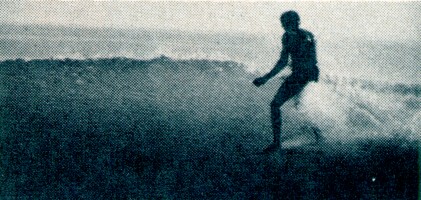 John Peck dead center. Pocket surfing or noseriding? |
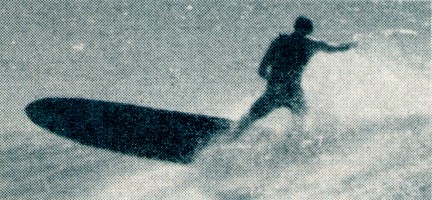 Coop, reverse shoulder. Blue
Machine
|
Page 9
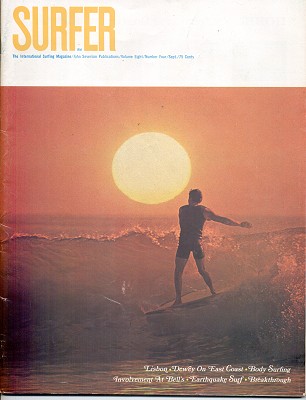 |
Volume 8 Number 4 September 1967. Cover:
Copy courtesy of Graham Sorensen Collection. |

| home | catalogue | history | references | appendix |